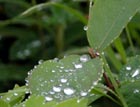Ways in which Rain Benefits the Garden
Kathryn Bradley Hole find reasons to be cheerful as the rain finally begins to fall...


It has been a good year for slugs and snails. Good for gardeners, that is. One of the few benefits of the mean drought this summer has been the lack of mollusc damage, as they were rendered immobile in the dry weather. But then it came: rain at last. In the middle of the night, I listened gratefully to the down-pour; a pitter-patter at first, then great riverfuls of it emptying out of the sky.
The snails were elated, too, and slithered out to feast, but I'll leave them to it, as Mother Blackbird is tackling them with gusto. Having successfully raised two broods this year in the thorny shelter of pyracantha thickets, she is at last taking some time to feed herself, and clearly has as much of a taste for snails as do our Gallic friends. I admire her persistence as she carries a snail in her beak onto the terrace or a patch of chunky gravel and then slaps it back and forth along the hard surface until its shell is shattered and the slimy contents can be winched out. Apparently, snails can sit out a drought for weeks or even months, curled up in their shells until rain returns, but when it does, they have some catching up to do and slither about by day as well as night. I hope the blackbirds keep busy.
Certain plants look particularly fetching in the rain. One is Fatsia japonica, whose tropical-looking palmate leaves appear all the better for being drenched; another is the papyrus, which relishes wet ground and gathers raindrops into shimmering tiaras. Cyperus papyrus is not completely hardy, so I keep it in large pots to bring indoors when cold weather approaches. It is, however, very easy to propagate, and now is as good a time as any. Unless you particularly need to split up the clump, just cut off a stem and plunge it head-first into some water; new roots will shoot out from the spidery topknot, in imitation of what it naturally does in the wild, when weak stalks bend in half and wash their tresses in the Nile.
There is still time to take cuttings of many other plants. As my greenhouse space is scarce, I stick to reliable, tender things I know we will want again next year, such as favourite and unusual pelargoniums, delicately coloured impatiens and fragrant heliotropes. Sprigs of impatiens root easily in just a glass of water, but for most things, it is worth buying a proprietary seeds-and-cuttings compost which has the right level of nutrients and drainage and has been sterilised.
The newspapers declared recently that the 'worst of the drought is over', but it will be too little, too late for many horticultural businesses. It seems that more than a third of UK garden centres and nurseries are in danger of financial ruin as a result of successive cold, late springs and this year's follow-on heat and dust.
Garden centres selling barbecues, garden furniture and water butts have fared better, but few people were inspired to buy plants which they would have had to plunge into parched ground and then been unable to water satisfactorily. So traditional nurseries need customers more than ever, and there are bargains to be had at present.
For example, I called at a specialist rose nursery which normally tides itself over the summer months selling potted-up roses, although its main business is still in the traditional bare-root planting period from November to March. In a good (i.e. non-drought) summer, trade is swift, as customers can wander along the rows of roses in its fields, jotting down favourites in their full, flowering glory, and then buy them on the spot. This summer, however, they sold their potted roses at two for the price of one a bargain I found quite irresistible.
Exquisite houses, the beauty of Nature, and how to get the most from your life, straight to your inbox.
Consequently, my brother was thrilled at receiving twice as many roses for his birthday than he might have had; I felt a warm glow of generosity and the nursery did good busi-ness. A happy tale of all-round success in times of adversity, in other words.
This article first appeared in COUNTRY LIFE magazine on September 7, 2006
Country Life is unlike any other magazine: the only glossy weekly on the newsstand and the only magazine that has been guest-edited by His Majesty The King not once, but twice. It is a celebration of modern rural life and all its diverse joys and pleasures — that was first published in Queen Victoria's Diamond Jubilee year. Our eclectic mixture of witty and informative content — from the most up-to-date property news and commentary and a coveted glimpse inside some of the UK's best houses and gardens, to gardening, the arts and interior design, written by experts in their field — still cannot be found in print or online, anywhere else.
